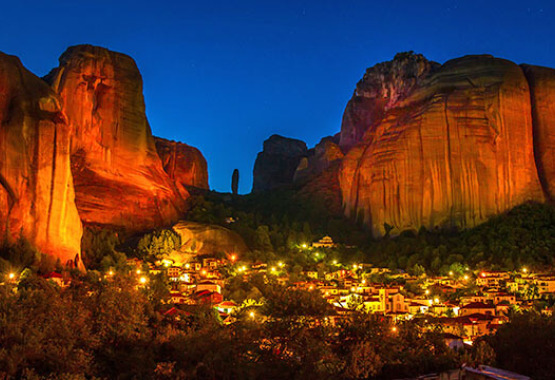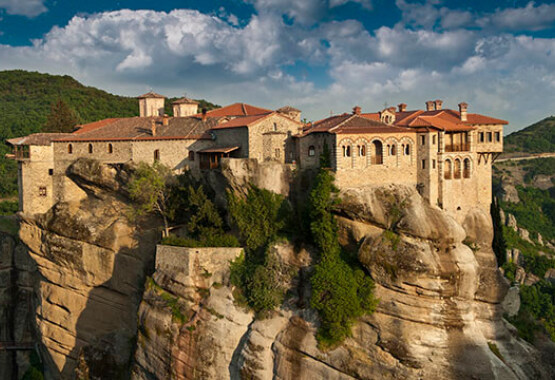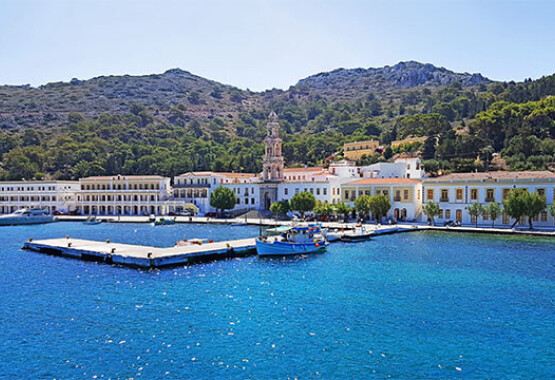
KALABAKA
Most of the 30 monasteries, founded in the 14th century, are now deserted. Only six of them are still open and resonate with religious traditions and the deep godliness of old times.
During the Holy Week, the mass starts at 19:00 and finishes around 21:00. At midnight on Easter Saturday when the resurrection is announced, the doors of the monasteries open to welcome those who want to attend the whole of the religious ritual.
Maundy Thursday is unique at the Varlaam monastery for the mass of the Last Supper and the Passions: the 12 gospels tell the story of Jesus Christ’s way to Calvary. In the eerie sounds of the bells ringing mournfully, the believers take part in the divine drama to attain a spiritual and moral elevation themselves.
On Good Friday, the Epitaphs are decorated and the scent of incense and lilac fills the atmosphere. The icons seem to weep in the pale candle light. The devout visitors of the monasteries lean their heads in humbleness and breathe in serenity in the place where time seems to stand still.
On Easter Sunday and the following days too, a traditional custom is definitely worth a visit. It is paschalogiorta (=Easter festivities) in the town of Kalabaka. The scent of lamb on the spit intoxicates your lungs everywhere, while the Easter-related dishes paspaliáres (= pies made with corn flour and baked in clay pots) and basiordí (=pork preserved in its fat) together with endless quantities of wine double the pleasure of singing and dancing along!
Easter at Meteora
The gigantic complex of over 800 dark rocks is not only one of the most awe-inspiring corners of the planet, but also a very important place for the Orthodox Church. Spirituality and the grandeur of nature converse with each other to give the thousands of visitors flocking from all over the world a lifetime experience.Most of the 30 monasteries, founded in the 14th century, are now deserted. Only six of them are still open and resonate with religious traditions and the deep godliness of old times.
Easter rituals
At Easter, the monasteries at Meteora guarantee you will really feel what these days are all about. Experience the awe and the ecstasy and let humbleness lead you through the mystic atmosphere to purification.During the Holy Week, the mass starts at 19:00 and finishes around 21:00. At midnight on Easter Saturday when the resurrection is announced, the doors of the monasteries open to welcome those who want to attend the whole of the religious ritual.
Maundy Thursday is unique at the Varlaam monastery for the mass of the Last Supper and the Passions: the 12 gospels tell the story of Jesus Christ’s way to Calvary. In the eerie sounds of the bells ringing mournfully, the believers take part in the divine drama to attain a spiritual and moral elevation themselves.
On Good Friday, the Epitaphs are decorated and the scent of incense and lilac fills the atmosphere. The icons seem to weep in the pale candle light. The devout visitors of the monasteries lean their heads in humbleness and breathe in serenity in the place where time seems to stand still.
On Easter Sunday and the following days too, a traditional custom is definitely worth a visit. It is paschalogiorta (=Easter festivities) in the town of Kalabaka. The scent of lamb on the spit intoxicates your lungs everywhere, while the Easter-related dishes paspaliáres (= pies made with corn flour and baked in clay pots) and basiordí (=pork preserved in its fat) together with endless quantities of wine double the pleasure of singing and dancing along!




